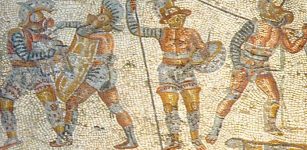Ancient Syriac Epitaphs Discovered In Tomb Of Priest Monoha Shed New Light On The Assyrian Empire
Conny Waters – AncientPages.com – Archaeologists are still trying to determine the age of the unearthed tomb that belonged to Priest Monoha, but preliminary studies show the burial is very old.
The tomb was discovered next to the historical Hasuni Caves in the southeastern Turkish province of Diyarbakır.
Inside the tomb, scientists found two ancient epitaphs written in Syriac. Daily Sabah reports, “it was the first discovery of its kind in Turkey, as epitaphs featuring this particular dialect, which draws from the ancient Aramaic language, have never been in stone tombs before in the country.”
Two ancient epitaphs inscribed in Syriac were discovered in the tomb. Credit: DHA
According to İrfan Yıldız from the Dicle University the script record “records that a priest called Monoha is buried here and that everyone who reads the inscription should pray for him.”
Archaeologists will now carry out further research to identify the origin of the discovered gravestone and the tomb where it was found. “We don't know exactly when this tomb was built, but from a first glance at the ruins and epitaphs, we can surely say that it is very old,” Yıldız said.
See also:
Tiglath Pileser III: Neo-Assyria’s Strong King Who Built A Mighty Empire
Clay Tablets Of Assyrian ‘King Of The World’ Esarhaddon Found Beneath Biblical Tomb Of Jonah
The Black Obelisk Of Shalmaneser III – Great Assyrian Ruler
This latest discovery may help scientists to learn more about the Assyrian civilization that traces its heritage back to ancient Mesopotamia.
The Assyrians came to preside over a number of powerful empires and dynasties and contributed greatly to the land's reputation as the "Cradle of Civilization."
An Assyrian protective spirit. Credit: Public Domain
Located about sixty miles to the south of the city of Mosul, Iraq, and situated south of Nineveh the Assyrians built the city of Ashur that served as their first capital and religious center.
Having given birth to the Sumerian, Akkadian, and Babylonian empires, Assyria reached a height of technological, scientific and cultural sophistication that was unrivaled for the time.
Ruins of the Assyrian city, Ashur. Image source
The ancient Assyrians were brilliant scientists and astronomers who studied the sky with great interest. Their scientific achievements have been documented on cuneiform tablets, one of the earliest writing systems invented by the Sumerians.
They spoke a Semitic language distinct from Arabic and the discovered ancient Syriac epitaphs may eventually shed more light on this one powerful ancient civilization.
Written by Conny Waters - AncientPages.com Staff Writer























